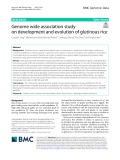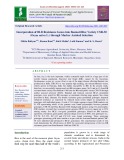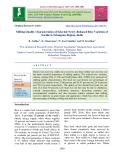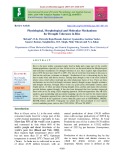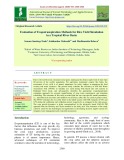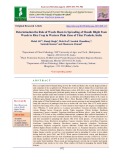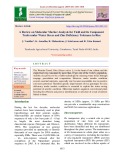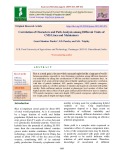
Rice is a staple food consumed
-
Glutinous rice as a special endosperm type is consumed as a staple food in East Asian countries by consumers’ preference. Genetic studies on glutinous rice could be conducive to improve rice quality and understand its development and evolution.
 15p
15p  vihagrid
vihagrid
 30-01-2023
30-01-2023
 13
13
 3
3
 Download
Download
-
In Asia, rice is the most important, widely consumed staple food for a large part of the world's human population. Bacterial leaf blight (BB), caused by the bacterium, Xanthomonas oryzae pv. oryzae (Xoo) is one of the major disease affecting Basmati rice production in India. CSR-30 is a very popular high yielding, salt tolerant Basmati variety widely grown in Haryana, India but highly susceptible to BB.
 13p
13p  trinhthamhodang11
trinhthamhodang11
 27-04-2021
27-04-2021
 19
19
 2
2
 Download
Download
-
Brown rice recovery, milled rice recovery and head milled rice recovery are the three essential parameters of milling quality. The selected rice varieties, namely, Anjana (JGL-11118) and Pradhyumna (JGL-17004) were analysed for milling quality characteristics.
 3p
3p  caygaocaolon8
caygaocaolon8
 07-11-2020
07-11-2020
 10
10
 1
1
 Download
Download
-
Rice is the most widely consumed staple food in India and a large part of the world's human population, especially in Asia. In this review we discussed about the Morphological and molecular mechanisms for drought tolerance in rice. Rice requires high temperature above 200C but not more than 35 to 400C. The lots of work have been done in this area to find out the cultivars, resistance to drought.
 14p
14p  nguaconbaynhay8
nguaconbaynhay8
 13-10-2020
13-10-2020
 9
9
 1
1
 Download
Download
-
Rice is the world's most consumed cereal grain, making up the dietary staple food of more than 60 percent of the world's population. For agriculture dominated country like India, the assessment of rice yield is of utmost importance for policy makers in managing the food security and water resources.
 7p
7p  caygaocaolon6
caygaocaolon6
 30-07-2020
30-07-2020
 15
15
 2
2
 Download
Download
-
Rice is a staple food for human being all over the world and India is the second largest producer and consumer of rice at global level. Production of rice in India is limited by several biotic and abiotic factors. Rice sheath blight (Rhizoctonia solani AG1-IA) is one of the most important factor causes significant grain yield and quality losses at worldwide. Yield losses of up to 50% have been reported under most conducive environments in India. Several uncultivated (weeds) and cultivated plant species are known to act as alternate and collateral hosts of R.
 11p
11p  caygaocaolon3
caygaocaolon3
 09-03-2020
09-03-2020
 10
10
 1
1
 Download
Download
-
The Wonder Cereal, Rice (Oryza sativa L.) is the heart of our culture and the staple food crop consumed by more than 50 per cent of the world’s population. Aerobic rice proves to be a viable technology by reducing water losses through seepage, percolation and evaporation. However, under aerobic condition several essential nutrients, especially zinc became unavailable due to positive soil redox potential. Therefore genetic improvement of rice genotypes for zinc deficiency under aerobic condition is essential to exploit the water saving potential of aerobic condition.
 6p
6p  nguathienthan2
nguathienthan2
 19-12-2019
19-12-2019
 8
8
 0
0
 Download
Download
-
Rice is an important staple food for more than half of the world’s population. Especially in Asian countries, rice is a major contributor to dietary Glycemic load (GL). Glycemic index (GI) of different varieties of rice (Oryza sativa L.) commonly consumed in are not widely studied even though it is the staple food. To determine the proximate compositions and the GI of three different rice flakes, namely Milled Rice, Mappilai samba rice and Red kavuni rice. The study was a randomised cross over study using healthy Farm women (n=15).
 4p
4p  kequaidan2
kequaidan2
 13-12-2019
13-12-2019
 12
12
 0
0
 Download
Download
-
Rice as a cereal grain is the most widely consumed staple food for a large part of world’s human population, especially in Asia. Estimation correlation among different characters was undertaken by taking into consideration 8 CMS line and their maintainer lines. At genotypic level, grain yield per plant showed highly significant and positive correlation with date of panicle initiation, 50% panicle emergence, 100% panicle emergence, panicle per plant, no. of tillers and days of maturity and negatively correlated with pollen sterility.
 6p
6p  kequaidan2
kequaidan2
 11-12-2019
11-12-2019
 9
9
 0
0
 Download
Download
CHỦ ĐỀ BẠN MUỐN TÌM









